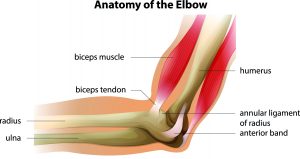Elbow
Your elbow is a hinged joint made up of 3 bones: your upper arm bone (humerus) and the two bones in your forearm (ulna and radius). Muscles, ligaments, and tendons hold the elbow joint together, to form the joint capsule- a fluid filled sac that surrounds and lubricates the joint.

Muscles
The muscles in your forearm cross the elbow and attach to the humerus. The bony bump on the outside (lateral side) of the elbow is called the lateral epicondyle, while the bump on the inside of your arm is called the medial epicondyle.
Ligaments
The important ligaments of the elbow consist of the medial collateral ligament (on the inside of the elbow) and the lateral collateral ligament (on the outside of the elbow). These ligaments work together to stabilise the elbow, holding the humerus, radius and ulna tightly together. Another ligament called the annular ligament holds the radial head tightly against the ulna.
Tendons
The tendons in your elbow attach muscle to bone. The biceps tendon attaches the biceps muscle on the front of your arm, and the triceps tendon attaches the triceps muscle to the back of your arm.
Nerves
The arm consists of nerves that travel down and move across the elbow. There are three main nerves: the radial nerve, the ulnar nerve and the medial nerve. These nerves are responsible for controlling your muscles and sensations, such as touch, pain and temperature.











